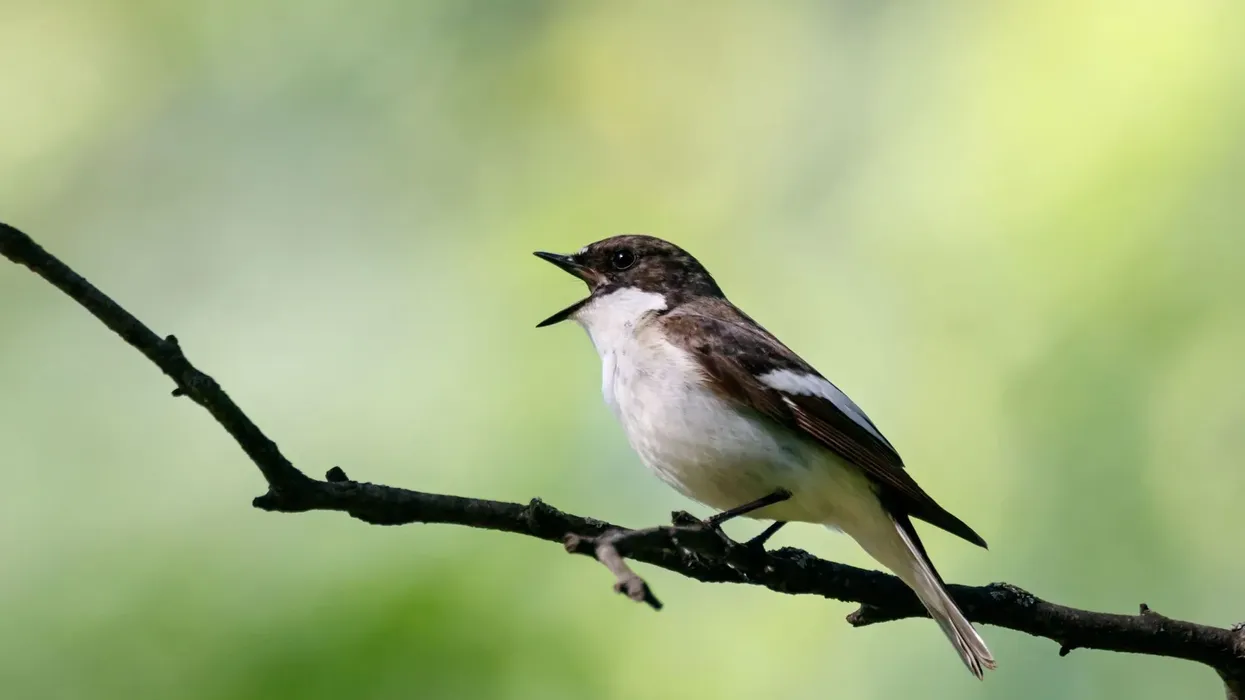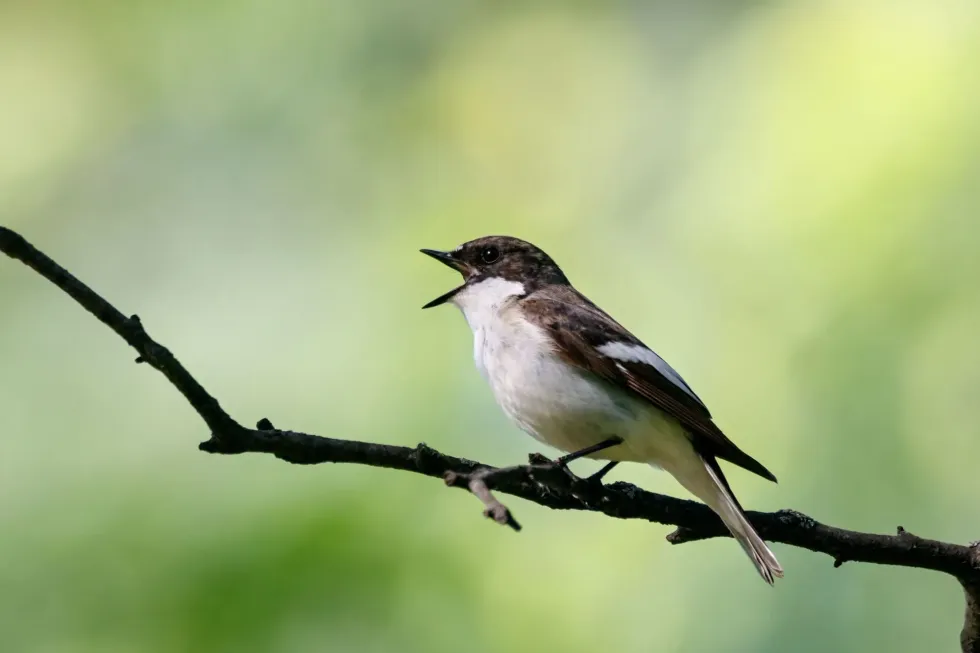The European pied flycatcher (Ficedula hypoleuca) is a bird species from the order passeriformes that is found all all over Europe and Scotland, and especially near any deciduous forests where they can easily find a nesting site. This birds species is easily identified through the white patch that can be seen on the forehead, right above the bill.
This insectivorous species, during migration, can be seen in places such as Africa, where the weather is more amiable as opposed to their summer habitat. While they do choose to spend the winters away from home, you will hardly find one of these birds breeding in any parts of the world apart from in Europe and Russia.
For more relatable content, check out these hummingbird facts and ani bird facts for kids.
European Pied Flycatcher Interesting Facts
What type of animal is a European pied flycatcher?
The European pied flycatcher is one of the old world flycatchers from the passeriformes order.
What class of animal does a European pied flycatcher belong to?
The scientific term for the class of animals that the European pied flycatcher belongs to is that of Aves, however, we may just as well classify them as birds.
How many European pied flycatchers are there in the world?
Unfortunately, the distribution of the population of the European pied flycatcher is so extensive that a definite number can not be outlined. However, it is apparent from varied populations and the conservation status of these birds that they will be around for a long time to come!
Where does a European pied flycatcher live?
The European pied flycatcher habitat consists of lowland woodlands and forests. They particularly prefer forests with a lot of wood cover so that they can nest in tree cavities. These nesting tree cavities are mostly easily found in deciduous forests - which see the largest populations of the species.
What is a European pied flycatcher's habitat?
The European pied flycatcher range map extends throughout the United Kingdom. These birds spend the summer season in Europe and in parts of Scotland, and breed throughout Europe. They can also be seen to be breeding in west Russia.
During the winter season, these migratory birds move towards North and West Africa or parts of West Asia.
Who do European pied flycatchers live with?
Not much is known about the social behavior of the European pied flycatcher. At the same time, it can be assumed from the fact that these birds are migratory, that they form small or large flocks during the winter season.
The only time of the year that these old world flycatchers can be seen to be aggressive is during the breeding season, when they are guarding their nesting site.
How long does a European pied flycatcher live?
The maximum lifespan of the European pied flycatcher is of around 15 years, while the average lifespan in the wild is around two to three years.
How do they reproduce?
The European pied flycatcher breeds during the summer season. Throughout the length of the breeding season, the male European pied flycatcher can be heard singing its beautiful song as it tries to search for a mate. The song, however, is absent in the species after the summer season is over.
The European pied flycatcher female birds makes their nests in trees that have a hole. Once the eggs are laid, the female bird takes up the responsibility of incubating the eggs, while the male bird guards the mother bird and the European pied flycatcher nestlings from becoming prey to larger birds.
What is their conservation status?
According to the IUCN Red List, the conservation status of the European pied flycatcher is that of Least Concern. This means that the population size of this species from the family muscicapidae is stable.
It is also clear that the range of western habitat that witnesses most of the distribution of the species is unlikely to face any rapid or irreversible degradation in the near future.
European Pied Flycatcher Fun Facts
What do European pied flycatchers look like?
Ficedula hypoleuca (scientific name) is a bird species that is easily recognizable from its set of very striking features. The male birds, during the breeding season, have a mainly black and white plumage which creates a monochromatic color palette.
The breeding male also has a small patch on its forehead, right above the black colored bill, which adds to how adorable the species is.
The non-breeding male has brown colored upper plumage, as opposed to black. The female is same in appearance as the non-breeding male, and is predominantly brown and white in color.
While we cannot say that the species has white wings, the feathers do end in a white color and make the species all the more pretty!

How cute are they?
There can hardly be any disputes regarding the fact that the European pied flycatchers are impeccably adorable birds! The brown or black upper body creates a sharp contrast with the white underparts. The white patch above the black colored bill, and the sweet song of the species and its subspecies add up to how attractive the species is!
How do they communicate?
These brown, or black and white colored birds have a soft call that is mainly heard during the breeding season. The male European flycatcher can be heard singing one of its melodious songs during the summer season, but after the season has passed, it may become silent.
This makes it difficult to spot these birds in gardens or in a woodland.
How big is a European pied flycatcher?
The average size of adult males or females of the European pied flycatcher species is of around 4.7-5.1 in (12-13 cm). For better perspective, red finches are roughly of the same size as our black and white colored friends.
How fast can a European pied flycatcher fly?
While the exact flight speed of the European flycatcher is not known, we do know that that their rounded wings and large wingspan facilitate travelling smoothly over long distances.
How much does a European pied flycatcher weigh?
The average weight of the adult European flycatcher has the range of around 0.2-0.7 oz (7-22 g). This black and white bird species from the family muscicapidae weighs almost twice as much as a vermilion flycatcher and at least six times as much as a rufous hummingbird!
What are the male and female names of the species?
Since there are no distinct names for males and females of European pied flycatcher species, we choose to lovingly refer to them as the male European pied flycatcher and the female European flycatcher respectively.
What would you call a baby European pied flycatcher?
The juvenile of the European pied flycatcher species would be called by the same name as all babies of the class of Aves - chick, nestling or juvenile.
What do they eat?
The European pied flycatcher diet mainly consists of insects that the birds catch as they are perched on trees in their natural habitat. They also feed on terrestrial or ground insects such as beetles and crickets.
The nestling feeds on small insects such as caterpillars.
Are they dangerous?
There are no records that would suggest that the European pied flycatchers can be dangerous to humans or any other animal species. The European pied flycatcher male is mainly aggressive during the breeding season, especially when the female has laid eggs and the grounds need to be checked for any predators or nest parasites.
Would they make a good pet?
While it is not a common practice to have a European pied flycatcher as a pet, it would not be a bad idea to have them as a member of your family either. The natural woodland habitat of this bird will be easy to mimic if given a nice nesting hole.
Their diet, however, may prove to be a point of concern since they feed on such a large selection of insects.
Did you know...
Migration in this species is common as the European pied flycatcher travels to warmer regions during winter!
Where can I find a European pied flycatcher?
European pied flycatchers are found in large numbers in gardens or woodlands across the map of Europe. You may also spot a few of these migrant birds perched on a tree as they are wintering in Western Africa or Northern Africa.
Do European pied flycatchers migrate?
European pied flycatchers migrate towards warmer regions during the winter season. The large wingspan and the rounded nature of the wings allow these birds to be able to travel over long distances, towards the Northern or Western parts of Africa. They, however, only breed in Europe and in parts of Russia.
Here at Kidadl, we have carefully created lots of interesting family-friendly animal facts for everyone to discover! For more relatable content, check out these least flycatcher facts and Hawaiian honeycreeper facts pages.
You can even occupy yourself at home by coloring in one of our free printable bird coloring pages.









